The dreaded brake warning light on your 2005 Toyota 4Runner can be a source of anxiety. Understanding why this light illuminates and how to address the issue is crucial for your safety and the longevity of your vehicle. This article will guide you through the common causes of a 2005 Toyota 4Runner brake warning light, troubleshooting steps, and potential solutions, empowering you to take control of the situation.
Common Causes of a 2005 Toyota 4Runner Brake Warning Light
Several factors can trigger the brake warning light in your 2005 4Runner. These range from simple issues like low brake fluid to more complex problems requiring professional attention. Here are some of the most frequent culprits:
- Low Brake Fluid: This is often the most common cause. A leak in the brake lines or worn brake pads can deplete your brake fluid levels.
- Worn Brake Pads: Brake pads have wear indicators that trigger the warning light when they reach a certain thickness. This signals it’s time for a brake pad replacement.
- Faulty Brake Sensor: The brake sensor can malfunction and illuminate the warning light even if there isn’t a genuine problem.
- Parking Brake Engaged: Sometimes, the simplest explanation is the correct one. Make sure your parking brake is fully disengaged.
- ABS Issues: Problems with the Anti-lock Braking System (ABS) can also trigger the warning light, often accompanied by the ABS warning light.
- Master Cylinder Problems: A failing master cylinder can cause a loss of brake pressure and activate the warning light.
Troubleshooting Your 2005 Toyota 4Runner Brake Warning Light
Before rushing to a mechanic, you can perform some basic troubleshooting steps to identify the potential cause of the illuminated brake warning light.
- Check the Parking Brake: Ensure the parking brake is fully released.
- Inspect Brake Fluid Level: Locate the brake fluid reservoir under the hood and check the fluid level. If it’s low, add brake fluid that meets the specifications in your owner’s manual.
- Visually Inspect Brake Pads: If you’re comfortable doing so, check the thickness of your brake pads through the wheel spokes. Thin pads indicate the need for replacement.
- Check for Leaks: Look for any signs of brake fluid leaks around the brake lines, calipers, and wheel cylinders.
When to Seek Professional Help for your 2005 Toyota 4Runner Brake Warning Light
If your troubleshooting efforts don’t reveal an obvious cause or if you’re uncomfortable working on your brakes, it’s time to seek professional help. A qualified mechanic can diagnose the problem accurately and perform the necessary repairs.
“Brakes are a critical safety system. Don’t hesitate to consult a professional if you’re unsure about anything,” advises Michael Stevens, ASE Certified Master Technician.
2005 Toyota 4Runner Brake Warning Light and ABS Issues
If your brake warning light is illuminated alongside the ABS warning light, the problem might reside within the ABS system. This requires specialized diagnostic equipment to pinpoint the fault.
What could cause the ABS light to come on with the brake light?
A faulty ABS wheel speed sensor, a problem with the ABS module, or a low brake fluid level could cause both lights to illuminate.
Maintaining Your 2005 Toyota 4Runner Braking System
Regular maintenance is essential for a safe and reliable braking system. Adhering to a preventative maintenance schedule can help avoid unexpected brake problems and keep your 2005 4Runner stopping smoothly.
- Regular Brake Inspections: Have your brakes inspected at least annually or as recommended in your owner’s manual.
- Timely Brake Pad Replacement: Replace your brake pads before they wear down completely to avoid damage to the rotors.
- Brake Fluid Flush: Flush your brake fluid every two to three years to prevent corrosion and maintain optimal brake performance.
“Preventative maintenance is always cheaper than emergency repairs,” says Sarah Chen, Automotive Engineer. “Regularly checking your brake fluid and having your brakes inspected can save you money and headaches down the road.”
Conclusion
Addressing the 2005 Toyota 4Runner brake warning light promptly is paramount for your safety. By understanding the potential causes, performing basic troubleshooting, and seeking professional help when needed, you can keep your 4Runner’s braking system in top condition and ensure safe travels. Don’t ignore this crucial warning signal – address it today.
FAQ
- Can I drive my 2005 Toyota 4Runner with the brake warning light on? While you might be able to drive, it’s strongly discouraged. It’s best to diagnose and address the issue immediately.
- How much does it cost to fix a 2005 Toyota 4Runner brake warning light issue? The cost varies depending on the underlying problem. A simple brake fluid top-up is inexpensive, while more complex repairs like ABS module replacement can be significantly more costly.
- How often should I check my brake fluid? Checking your brake fluid level monthly is a good practice.
- What type of brake fluid does a 2005 Toyota 4Runner use? Consult your owner’s manual for the specific brake fluid type recommended for your vehicle.
- Can I replace my 2005 Toyota 4Runner brake pads myself? If you have some mechanical experience, you can replace brake pads yourself. However, it’s always a good idea to consult a repair manual for specific instructions.
- What are the symptoms of a bad master cylinder in a 2005 Toyota 4Runner? A spongy or soft brake pedal, a low brake pedal, or a brake pedal that slowly sinks to the floor can indicate a bad master cylinder.
- How can I reset the brake warning light on my 2005 Toyota 4Runner? The brake warning light should reset automatically once the underlying problem is fixed. If it doesn’t, a professional mechanic can use a diagnostic tool to reset it.

